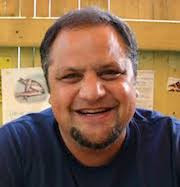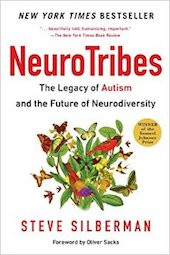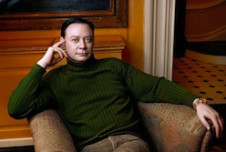Is autism a natural manifestation of human diversity—or a condition to be cured?
That’s the question at the heart of Steve Silberman’s NeuroTribes: The Legacy of Autism and the Future of Neurodiversity. Since the book was published last year, it has had a huge impact among disability rights activists, as well those who work with people diagnosed with “neuroatypical” conditions like Asperger’s, autism, ADHD, or dyslexia.
“A book like NeuroTribes is of great value at this moment in history because it brings public attention to the fact that autistic people are speaking and that it’s time for non-autistic society to start listening,” says Nick Walker, a prominent autistic teacher and writer. “One thing I’ve always appreciated about Steve Silberman is that he’s not just saying, ‘Listen to me’—he’s saying ‘Listen to autistic people.’”
Rather than view autism and other labels as “disorders,” neurodiversity activists like Walker say that the rainbow of brain makeups is similar to diversity found in skin color, or even the diversity of plants in an ecosystem. We spoke with Silberman about the impact of the presidential election on acceptance of neurodiversity—and the prospects of increased awareness and understanding through research, education, and advocacy.
 Steve Silberman
Steve Silberman
Jenara Nerenberg: Do we have overall numbers or a percentage on how many people in the world are “neurodivergent,” with diagnoses in, for example, autism or ADHD?
Steve Silberman: I’ve never put together those numbers but it’s not inconsiderable. For autism alone, the CDC says one in 68 school children are on the autism spectrum. We can assume from research that the number of adults is similar, which, by the way, dispenses with the idea of an epidemic or tsunami. Neurodiversity is simply recognizing the diversity that is already there—and then creating practical structures like employment, health care, and education to give everyone the maximum chance of success.
I think neurodiversity is a huge paradigm shift that is long overdue. And if you think about it, the notion that there is a normal brain and that’s the way it should work—in what other fields of biology do we think that? It’s like looking for the normal plant in the rainforest. Why wouldn’t human brains have that kind of diversity that actually contributes to the resilience of communities, especially if it’s also happening amongst animals and plants? Why would we be different?
JN: What is the opportunity for neurodivergent folks to join hands with other marginalized identity groups?
SS: Keep in mind that the notion that autistic people are disabled, rather than “diseased” or “disordered,” is still a relatively new and controversial idea. The necessity of society finally coming to see autism that way, and making the necessary accommodations in housing, employment, and the workplace—instead of viewing it as a mysterious plague caused by some hidden factor in the toxic modern era—is one of the main themes of NeuroTribes.
I was just in Washington celebrating the 10th anniversary of group called the Autistic Self-Advocacy Network. ASAN is run by autistic people, for autistic people, and its motto “Nothing about us, without us.” From the beginning, it has viewed building community with other disabled people, and situating its efforts within the broader “cross-disability” rights movement, as absolutely central to its mission. So they’ve forged alliances with groups like the Arc, the oldest disability-rights group in the country, which has traditionally highlighted self-advocacy by people with intellectual disability. ASAN is also in solidarity with self-advocates with physical disabilities, with people of color fighting racism, and with LGBT folks battling homophobia, bullying, and violence. In social justice circles, this way of thinking is known as “intersectional” activism.
Against a President Trump—and a coterie of advisors that includes blatant racists and anti-Semites—intersectional activism is the only viable pathway forward. I suspect the GOP’s strategy will be to overwhelm civil rights activists with so many attacks on so many different fronts that it will seem unstoppable. But these attacks must be stopped, and the best-case scenario is that the next four years will be a crucible in which a new generation of vibrant, creative, passionate, pragmatic, and fiercely determined activists will be forged.
JN: What areas in the research need more attention and can be improved or further developed?
SS: We have spent so much precious time, scarce resources, and a tremendous amount of money in hunting for the cause of autism in the human genome, and the potentially triggering factors in the environment. And that’s interesting science and it’s leading to potential applications someday, but there’s so much we don’t know that could help autistic people who are alive right now, rather than maybe someday coming up with a prenatal test to prevent them from ever being born, which is the unspoken direction of some of the research into causation.
Some of it is looking for nodular pathways in the brain that could be used to relieve stuff like anxiety, which is really good. But let me give you an example of science that’s been virtually ignored while we’ve been doing these genetic fishing expeditions. The leading cause of death for autistic adults with an intellectual disability is epileptic seizures, yet we have no idea how seizure-controlling drugs work in the autistic brain. We just use the research based on the neurotypical brain. And the thing is that epileptic seizures present themselves differently in the autistic brain. For instance, many autistic people start getting seizures at puberty, more so than neurotypicals. And that’s a really serious thing and yet we haven’t been looking at it because we haven’t been thinking in terms of what research can help autistic people thrive and in this case not die of seizures. Any older parent with an autistic adult child knows that seizures are really common and really frightening. And yet that research has not been done.
Another area that needs more attention is sensory sensitivity in autism, because it so much affects the quality of life for autistic people and the kinds of accommodations that could be created for them so that they can live more comfortably. And yet we still don’t understand it, in part, because sensory sensitivity was virtually off the research radar until the celebrated autistic designer Temple Grandin started talking about her experience. Because so much autism research was based on the assumptions that it was rare and only found in children—which are both wrong—we haven’t had much insight yet from autistic people in terms of what they really need. That’s starting to change, as adults very much demand a place in the conversation on autism. But researchers into autism should listen more to research suggestions from autistic people themselves, because they’re on the frontlines. It’s their lives.
Another thing is that we’re just now beginning to understand that autism presents very differently in women. A constant reiterated “fact”—that I think is totally wrong—is that autism is four times or eight times more common in guys, which is based on wrong or naive research. In fact, Kevin Pelphrey at Yale Child Study Center missed the signs of autism in his own daughter, even though he does nothing all day except evaluate kids for autism. And that’s because autism presents very differently in women. And he said basically everything we know about the autistic brain is based on the brains of men. And that’s another thing where mistaken beliefs have taken our eye off of living reality.
JN: How does autism present differently in women?
SS: There was recently a piece in Spectrum that talks about how women with autism become experts at pretending they don’t have autism. It could be that—and I don’t want to speak for autistic people—it could be that women are trained to sort of fade into the background, switch their remarks to sort of blend in, whereas guys, broadly-speaking, are rewarded for being little Donald Trumps. And the thing is that autistic kids often come to the attention of authorities—parents or teachers or clinicians—because of aggressive behavior. So it could be that since boys are socialized to be more aggressive, they are more visible as autistic kids. I think we need to start looking at those girls who are sort of quiet and are in the background but they’re intensely interested in their interests, whether it’s technology, pop culture, or music. But they’re not usually socially thriving. We should be looking more at them.
JN: Is there a particular area of neurodiversity research where you’re excited and where you’re seeing progress?
SS: There’s a huge multinational software company called SAP. Prompted by a couple different fathers, they launched a program called Autism At Work. Originally it was a pilot program in India where they were going to hire seven autistic workers, but it worked out to be so good for everybody, including the companies that were hiring, that they’ve expanded now into seven countries and committed to hiring thousands of autistic high-tech workers in the coming years. If you look at a list of what you should never do in a job interview and how to conduct yourself, it’s practically a list of what autistic people are not good at. Stuff like making firm eye contact, strong handshake, etc. Autistic people struggle with this. What they’re good at is doing the work.
Temple Grandin proved this by being an industrial designer who came out of the autistic closet and said that the way to approach work for autistic people is basically to show your portfolio. Don’t sell yourselves, because you probably won’t be that good at that, but sell your work, because your creative portfolio really does justice to your work.
Other companies are taking the same approach. One of Walmart’s distribution facilities is hiring not just autistic people but people with various forms of cognitive disability ranging from intellectual disability to dyslexia to ADHD. And that center became the most productive center for the entire US. What happens when autistic adults land a job where they’re appreciated for who they are—where they don’t have to conceal their autism and where they get the accommodations they need—is that their social skills often naturally develop at a rapid pace. So this is very good, both for autistic people looking for work, which is a huge problem, but also for the companies that are hiring them.
JN: What have you observed about how the conversation—in research, academia, or media—is shifting around other neurodivergences, such as ADHD or dyslexia?
SS: One of the things that’s happening is that changes in popular science writing are beginning to drive research. A husband-and-wife team wrote a book called The Dyslexic Advantage a few years ago and I think that prompted researchers to look more at the positive aspects of dyslexia. And I think a lot of people are looking toward something called Universal Design as a way of customizing core curricula to fit the needs and strengths of the individual learner in the classroom.
That’s a very useful way to think, because we live in a digital world where it’s not that hard to customize core curricula to play to the strengths of a visual learner or auditory learner. I think that’s really a way of thinking about education—and eventually the workplace—so that the untapped strengths of neurodivergent people can be tapped.
JN: How do you see the neurodiversity paradigm as particularly relevant right now, given recent political shifts?
SS: It’s important to remember that neurodiversity is not just a paradigm or a political stance, but a living fact. There are several distinct subtypes of human cognition hiding behind diagnostic labels like Autism Spectrum Disorder, dyslexia, and so on, and that diversity has played an important role in the functioning and flourishing of human society.
President-elect Trump has not shown himself to be a friend of any form of diversity, beyond praising the taco bowls at Trump Tower Grill in a tweet. He explicitly campaigned on racist themes and only recently made a weak statement on 60 Minutes that he was willing to put up with gay marriage because it was “settled law,” after saying weeks ago that he was strongly inclined to attempt to ban it. He grotesquely mocked a disabled New York Times reporter—and then denied what was obvious to anyone who saw the video. Meanwhile, he has blamed autism on vaccines for years, and Andrew Wakefield—the discredited former gastroenterologist who triggered the global vaccine/autism panic with a now thoroughly debunked paper—claimed to have a private meeting with Trump and endorsed him as the anti-vaccine President.
Let’s face it: Trump doesn’t even seem to like women very much, except as potential targets of harassment and abuse.
In other words, there is no evidence that Trump has any understanding of the importance of treating disabled people with respect and making accommodations for them, even those currently mandated by laws like the Americans with Disabilities Act. In the past two decades, his properties have been sued eight times for ADA violations.
Now all disabled people will need to band together and build alliances across communities and fight to preserve their rights, and prevent them from being steadily eroded in the coming years. Even the left has been somewhat slow to recognize that you can’t have civil rights if you leave disabled people behind. Benjamin Franklin said that if we don’t hang together, we shall surely hang separately, and that has never been more true than now.






Comments